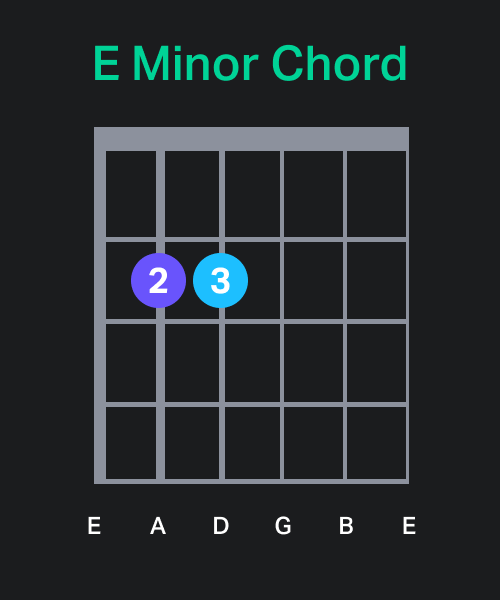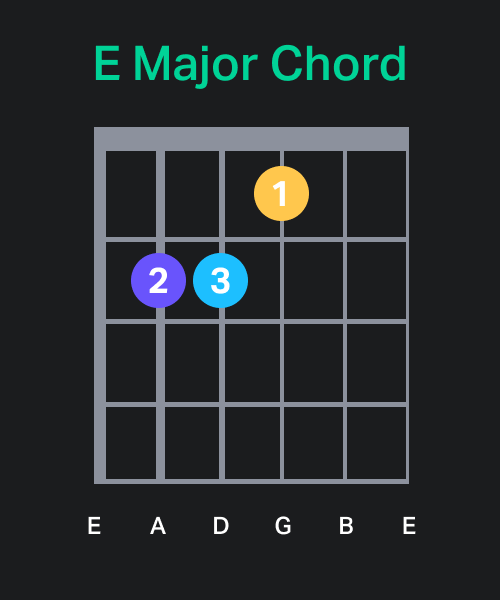News
Are you ready to take your guitar playing to the next level? In this article, we’ll teach you how to play the E chord on the guitar. We’ll walk you through the correct finger placement and technique to ensure you can play this essential chord with ease. With our step-by-step instructions, you’ll be strumming the E chord like a pro in no time.
Table of contents
Understanding the E chord
First, let’s define the following terms: notes, chords, and scales.
Notes are named after the letters of the alphabet and represent musical sounds. You can think of notes as the basic building blocks of music.
Chords can be described as a harmonic set of multiple notes. In other words, the notes can be compared to single letters, while the chords are like words.
Finally, a scale is a sequence of musical notes arranged in order of pitch based on their fundamental frequency.
In Western music, there are seven notes: A, B, C, D, E, F, and G. Depending on the scale you look at, these notes will be in a different order. For now, let’s focus on the E minor and E major scales.
Here are the notes in the E minor scale:
E – F# – G – A – B – C – D
And here are the notes in the E major scale:
E – F# – G# – A – B – C# – D#
How to play the E minor chord on guitar
The E chord is one of the first, and perhaps most important, chords to learn. Let’s begin by looking at the E minor chord (or Em). You can also use this as a starting point for playing the E major chord – all you have to do is fret one more string to transition from E minor to E major.
To play E minor on the guitar:
- Put your middle finger on the second fret of the fifth string.
- Put your ring finger on the second fret of the fourth string.
- Strum all six strings.
Here’s a guitar chord chart for E minor:

You may wonder why you need to use your middle and ring fingers to fret the strings. The reason is that keeping your index finger free makes it easier to transition to chords like C, A minor, and D major.
How to play the E major guitar chord
The E major chord is made up of E, G#, and B. It is also called an E major triad, consisting of three parts: E is the root, G# is the major third, and B is the fifth.
Here are detailed instructions for playing the E major chord on the guitar:
- Position your index finger on the first fret of the third string.
- Place your middle finger on the second fret of the fifth string.
- Place your ring finger on the second fret of the fourth string.
- Strum all six strings when playing the chord.

The E major and E minor chords are very similar. If you already know one of them, you’ll easily learn the other. All you need to do is change the position of one finger.
What’s the difference between minor and major chords?
A minor chord is very similar to a major chord, with just one notable difference. While a major chord is made up of the root note, major third, and fifth note of the scale, a minor chord consists of the root note, the minor third (one half-step lower than the major third), and the perfect fifth.
Both E and Em chords consist of E, G, and B. However, in E major, the third string is raised by a half-step, producing G# (or G# sharp) instead of G.
The E minor chord includes an open G string (G natural), which gives it its “minor” quality, whereas the E major chord replaces that note with a G♯. In other words, E minor contains E, G, and B (with G as a minor third), whereas E major contains E, G♯, and B (with G♯ as a major third).
This change results in a major third interval rather than a minor third, which distinguishes E major from E minor. This subtle difference is all it takes to transform a lively E major chord into a somber E minor chord.

Easy E chord variations
Learning to play a new chord is easier if you have a simple progression that helps you work toward the full chord shape. Besides, a simpler version of a familiar chord can be enough for some songs. Here are a few simple alternatives to the E chord you can try:
- One-finger E major chord: One alternative to the full E major chord shape is fretting only the first fret of the G string with your index finger and strumming just the three highest strings.
- E power chord (E5): This variation requires only a single finger on the fretboard. Just fret the second fret of the A string. Then, strum only the low E and A strings. You can add a second finger as well by fretting the D string at the second position with your middle finger and strumming the three bottom strings.
- E7 chord: The E7 chord shape is almost identical to Am, with just a slight difference. You can play the E7 chord using the same chord shape as Am; just don’t fret the D string with your ring finger. Play the D string open instead.
Is E minor the same as G major?
E minor and G major are not the same, although they are closely related and share the same key signature: one sharp (F♯). This means they use the same set of pitches. However, the main difference lies in their tonal centers: E minor has E as its tonic (home note), whereas G major has G as its tonic.
The E natural minor and G major scales are known as relative keys because they have the same pitches. In other words, G major is the relative major of E minor, and E minor is the relative minor of G major.
You can find a major key’s relative minor by counting down three semitones (a minor third) from its tonic note. The different starting points (E and G) result in distinct sounds and functions, even though both scales use the same pitches.

Common pitfalls and practice tips
When practicing new chords, it’s important to be aware of common pitfalls. One common issue for beginner guitarists is fret buzz. Unwanted buzzing in the strings can happen if your fingers aren’t pressing down close enough to the frets. Make sure to press the string right above the fret (the thin line on the fretboard) but not directly on top of it.
You might also mute the strings accidentally if your fingers aren’t arched properly. You can fix this issue by curling your fingers more and pressing the strings with your fingertips.
Develop a consistent practice routine to ensure steady progress. After memorizing the chord shape, improve your muscle memory by switching from one chord to the other until it becomes second nature. Increase your speed gradually as you become more comfortable.
Songs that use E minor and E major chord
There are many songs that use the E minor and E major chords, in addition to a few other common open chords. Here are just a handful of great songs to learn on the guitar that use chords in the key of E minor:
- “Nothing Else Matters”, made famous by Metallica
- “Livin’ On a Prayer”, made famous by Jon Bon Jovi
- “Take Me to Church”, made famous by Hozier
- “Fallin’”, made famous by Alicia Keys
The following songs are in the key of E major:
- “Where is My Mind”, made famous by Pixies
- “Isn’t She Lovely”, made famous by Stevie Wonder
- “Counting Stars”, made famous by OneRepublic
- “Candle in the Wind”, made famous by Elton John
Don’t stop your musical adventure with the E chords. With Yousician, you can explore music theory, master many other chords, and play your favorite songs. Get started with Yousician today with a free 7-day trial of Premium+.